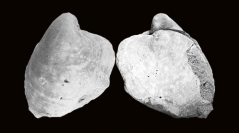

 Comptes Rendus Palevol
2 (6-7) - Pages 563-576
Comptes Rendus Palevol
2 (6-7) - Pages 563-576Polymorphism of R. suborbiculatum could be summed up as the double occurrence of individuals partially costulated and individuals completely smooth within the same population and a great inter-population variability of general size. After having put aside all altered assemblages, causes of these polymorphisms are analyzed from a palaeoenvironmental point of view and in terms of heterochronies of development. Environment seems to play a minor role in the control of these parameters. Among the several combinations between these two kinds of polymorphism, it is possible to observe a general trend to hypermorphosis during the Cenomanian-Turonian transgression.
Gryphaeidae, Rhynchostreon suborbiculatum , heterochronies, Cenomanian–Turonian, taphonomy, polymorphism, Aquitain Basin, palaeodemography, France